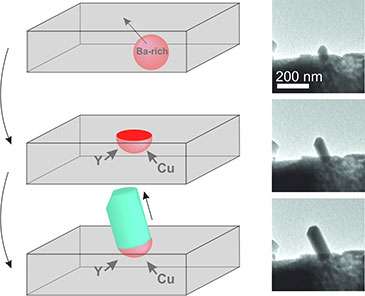New nanowire growth mechanism observed

(Phys.org) —A mechanism of growth of anisotropic metal oxides that was predicted 20 years ago has been observed for the first time by researchers at the University of Bristol. The work is described in an article published this week in Science.
The fabrication of nanowires of ternary and quaternary functional materials has become an important goal for their application in miniaturized circuits as diodes and transistors, coaxial gates and sensors.
The growth mechanisms are complex however and invariably proceed via a vapour-liquid-solid process which results in nanowires with a tapering morphology. A nanowire that tapers is undesirable for applications, as functionality would vary along the length, and perhaps even vanish, once a critical size was reached.
Dr Simon Hall and Rebecca Boston in the School of Chemistry, along with colleagues in the University of Birmingham and the National Institute for Materials Science in Tsukuba, Japan have successfully grown nanowires of a phase of the superconductor yttrium barium copper oxide that have a constant cross-sectional area.
In doing so, they engineered their syntheses to proceed via the so-called 'microcrucible mechanism' of crystal growth. This mechanism was first proposed to account for the growth of certain macroscopic metal oxide whiskers in 1994, but has never been observed at any length scale until now.
The team achieved the first observation of this growth mechanism by using a high-resolution transmission electron microscope with video capture and an in-situ furnace. This enabled them to directly observe molten nanoparticles of barium carbonate migrating through a porous yttrium and copper-rich matrix, catalysing nanowire outgrowth from nano-sized microcrucibles on reaching the surface.
Dr Simon Hall said: "Nanowires produced in this way will have the same physical properties along their entire length, leading to more uniform current-carrying ability, ferroic behaviour and tensile strength.
"This work could pave the way for the next generation of devices that use new, high-performance functional materials as their key component."
More information: "In Situ TEM Observation of a Microcrucible Mechanism of Nanowire Growth," Rebecca Boston, Zoe Schnepp, Yoshihiro Nemoto, Yoshio Sakka, Simon R. Hall. Science 9 May 2014: Vol. 344 no. 6184 pp. 623-626. DOI: 10.1126/science.1251594
Journal information: Science
Provided by University of Bristol




















